Analysis of Effective Management in Health: Journal Reflection
VerifiedAdded on 2022/09/28
|17
|4906
|21
Journal and Reflective Writing
AI Summary
This management journal analyzes an incident in a hospital setting, focusing on the impact of leadership styles and management decisions on workplace culture and patient outcomes. The student examines a nursing shortage in a medical-surgical ward, exploring the differing approaches of two senior professionals, Dr. Thomas and Dr. David, in addressing the crisis. The journal details the incident, including the implementation of overtime shifts and the use of nurses from other departments, leading to medication errors and increased stress. The student employs Rolfe's reflective model to analyze the incident, considering the questions of 'What?', 'So What?', and 'Now What?' to draw conclusions about effective management practices. The analysis highlights the importance of proactive leadership, communication, and the need for managers to synergize teams. Furthermore, it reflects on the positive changes in Dr. Thomas' personality and management style, as he became more open to criticism and actively involved in addressing the nurses' concerns. The journal concludes with a discussion of management theories, such as transactional and transformational leadership, and their practical application in resolving the crisis. The student emphasizes the impact of effective leadership on team morale, patient care, and the overall workplace culture. The journal also highlights the importance of training and development in healthcare settings and the need for leaders to prioritize employee well-being.
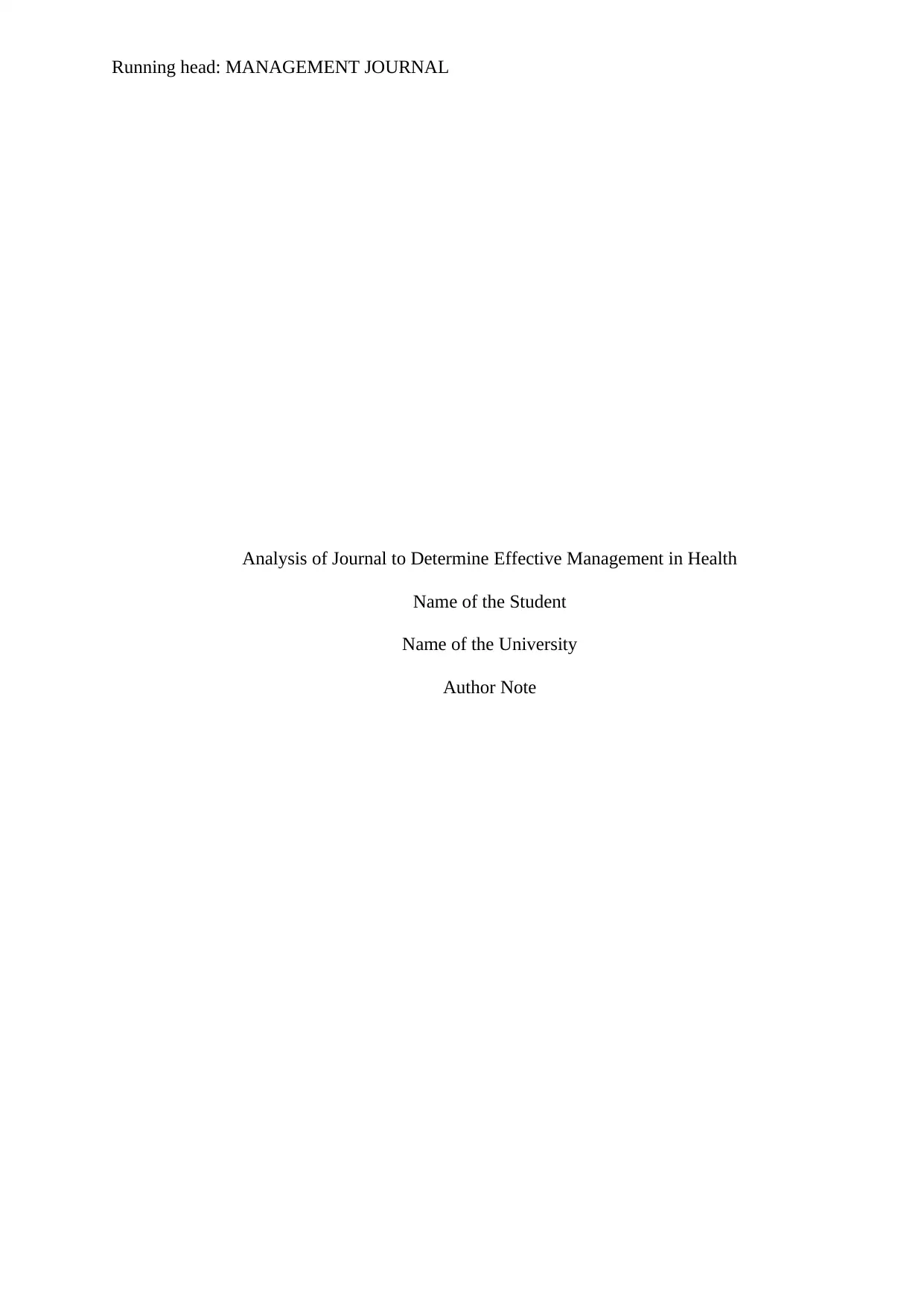
Running head: MANAGEMENT JOURNAL
Analysis of Journal to Determine Effective Management in Health
Name of the Student
Name of the University
Author Note
Analysis of Journal to Determine Effective Management in Health
Name of the Student
Name of the University
Author Note
Paraphrase This Document
Need a fresh take? Get an instant paraphrase of this document with our AI Paraphraser
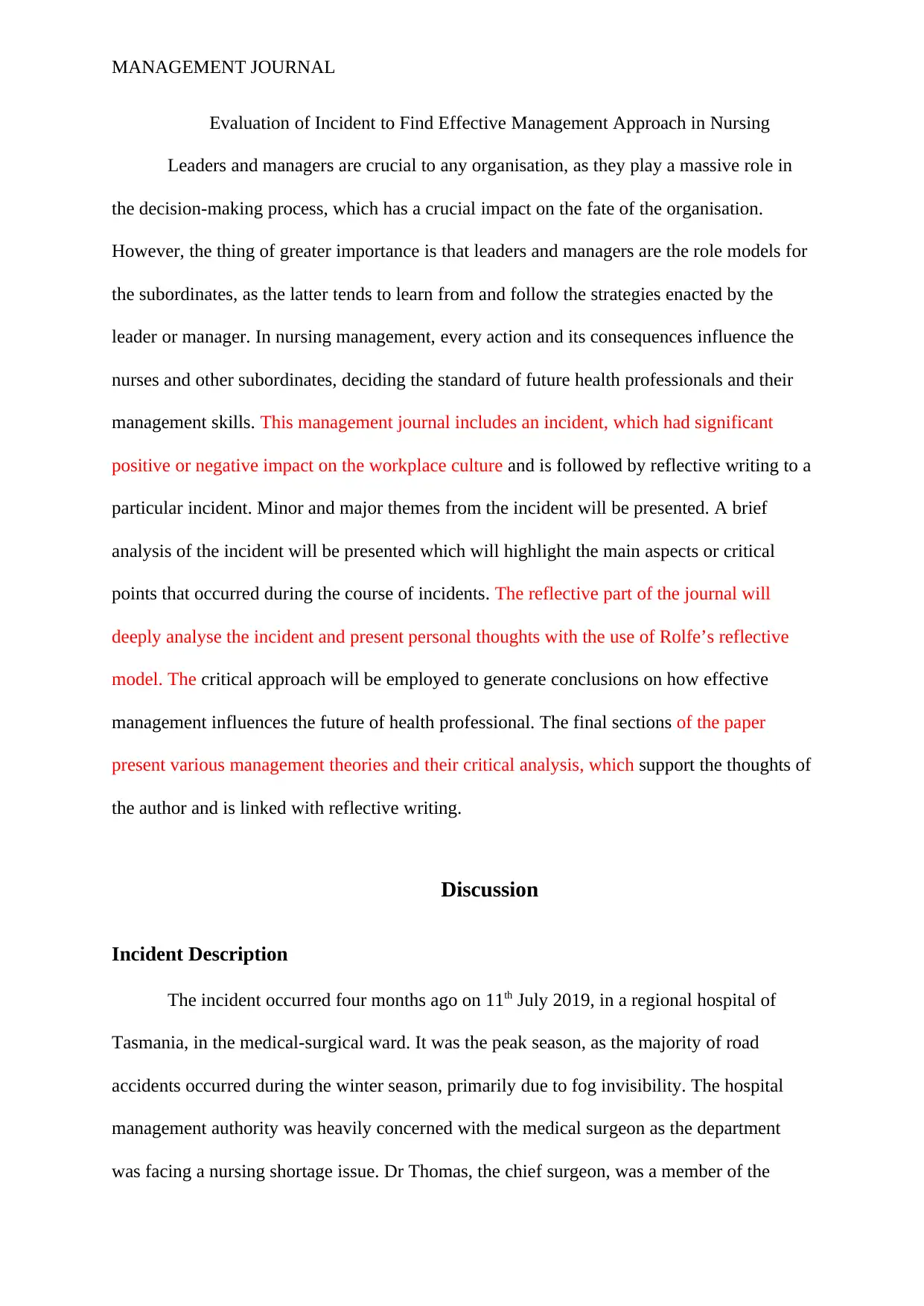
MANAGEMENT JOURNAL
Evaluation of Incident to Find Effective Management Approach in Nursing
Leaders and managers are crucial to any organisation, as they play a massive role in
the decision-making process, which has a crucial impact on the fate of the organisation.
However, the thing of greater importance is that leaders and managers are the role models for
the subordinates, as the latter tends to learn from and follow the strategies enacted by the
leader or manager. In nursing management, every action and its consequences influence the
nurses and other subordinates, deciding the standard of future health professionals and their
management skills. This management journal includes an incident, which had significant
positive or negative impact on the workplace culture and is followed by reflective writing to a
particular incident. Minor and major themes from the incident will be presented. A brief
analysis of the incident will be presented which will highlight the main aspects or critical
points that occurred during the course of incidents. The reflective part of the journal will
deeply analyse the incident and present personal thoughts with the use of Rolfe’s reflective
model. The critical approach will be employed to generate conclusions on how effective
management influences the future of health professional. The final sections of the paper
present various management theories and their critical analysis, which support the thoughts of
the author and is linked with reflective writing.
Discussion
Incident Description
The incident occurred four months ago on 11th July 2019, in a regional hospital of
Tasmania, in the medical-surgical ward. It was the peak season, as the majority of road
accidents occurred during the winter season, primarily due to fog invisibility. The hospital
management authority was heavily concerned with the medical surgeon as the department
was facing a nursing shortage issue. Dr Thomas, the chief surgeon, was a member of the
Evaluation of Incident to Find Effective Management Approach in Nursing
Leaders and managers are crucial to any organisation, as they play a massive role in
the decision-making process, which has a crucial impact on the fate of the organisation.
However, the thing of greater importance is that leaders and managers are the role models for
the subordinates, as the latter tends to learn from and follow the strategies enacted by the
leader or manager. In nursing management, every action and its consequences influence the
nurses and other subordinates, deciding the standard of future health professionals and their
management skills. This management journal includes an incident, which had significant
positive or negative impact on the workplace culture and is followed by reflective writing to a
particular incident. Minor and major themes from the incident will be presented. A brief
analysis of the incident will be presented which will highlight the main aspects or critical
points that occurred during the course of incidents. The reflective part of the journal will
deeply analyse the incident and present personal thoughts with the use of Rolfe’s reflective
model. The critical approach will be employed to generate conclusions on how effective
management influences the future of health professional. The final sections of the paper
present various management theories and their critical analysis, which support the thoughts of
the author and is linked with reflective writing.
Discussion
Incident Description
The incident occurred four months ago on 11th July 2019, in a regional hospital of
Tasmania, in the medical-surgical ward. It was the peak season, as the majority of road
accidents occurred during the winter season, primarily due to fog invisibility. The hospital
management authority was heavily concerned with the medical surgeon as the department
was facing a nursing shortage issue. Dr Thomas, the chief surgeon, was a member of the
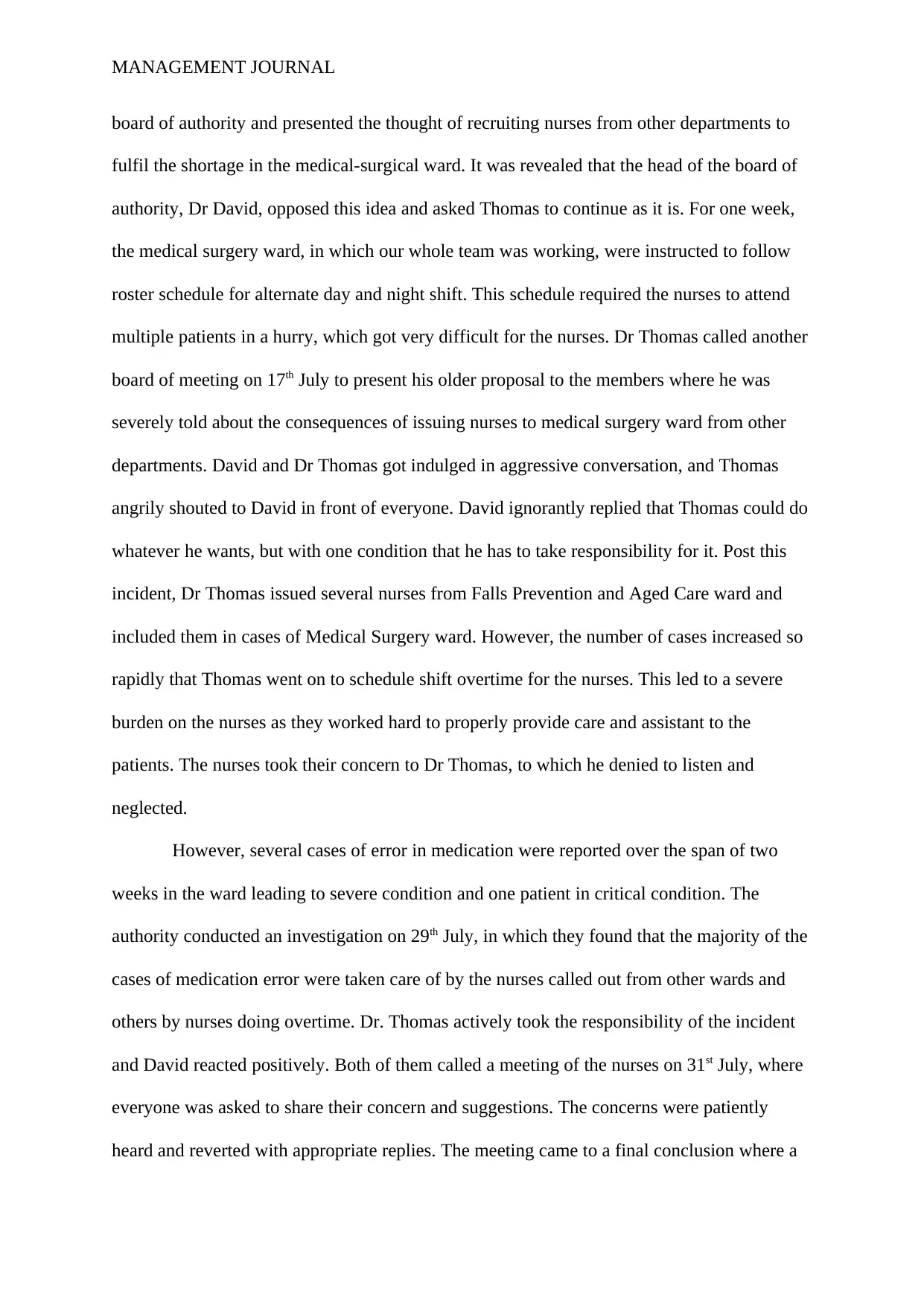
MANAGEMENT JOURNAL
board of authority and presented the thought of recruiting nurses from other departments to
fulfil the shortage in the medical-surgical ward. It was revealed that the head of the board of
authority, Dr David, opposed this idea and asked Thomas to continue as it is. For one week,
the medical surgery ward, in which our whole team was working, were instructed to follow
roster schedule for alternate day and night shift. This schedule required the nurses to attend
multiple patients in a hurry, which got very difficult for the nurses. Dr Thomas called another
board of meeting on 17th July to present his older proposal to the members where he was
severely told about the consequences of issuing nurses to medical surgery ward from other
departments. David and Dr Thomas got indulged in aggressive conversation, and Thomas
angrily shouted to David in front of everyone. David ignorantly replied that Thomas could do
whatever he wants, but with one condition that he has to take responsibility for it. Post this
incident, Dr Thomas issued several nurses from Falls Prevention and Aged Care ward and
included them in cases of Medical Surgery ward. However, the number of cases increased so
rapidly that Thomas went on to schedule shift overtime for the nurses. This led to a severe
burden on the nurses as they worked hard to properly provide care and assistant to the
patients. The nurses took their concern to Dr Thomas, to which he denied to listen and
neglected.
However, several cases of error in medication were reported over the span of two
weeks in the ward leading to severe condition and one patient in critical condition. The
authority conducted an investigation on 29th July, in which they found that the majority of the
cases of medication error were taken care of by the nurses called out from other wards and
others by nurses doing overtime. Dr. Thomas actively took the responsibility of the incident
and David reacted positively. Both of them called a meeting of the nurses on 31st July, where
everyone was asked to share their concern and suggestions. The concerns were patiently
heard and reverted with appropriate replies. The meeting came to a final conclusion where a
board of authority and presented the thought of recruiting nurses from other departments to
fulfil the shortage in the medical-surgical ward. It was revealed that the head of the board of
authority, Dr David, opposed this idea and asked Thomas to continue as it is. For one week,
the medical surgery ward, in which our whole team was working, were instructed to follow
roster schedule for alternate day and night shift. This schedule required the nurses to attend
multiple patients in a hurry, which got very difficult for the nurses. Dr Thomas called another
board of meeting on 17th July to present his older proposal to the members where he was
severely told about the consequences of issuing nurses to medical surgery ward from other
departments. David and Dr Thomas got indulged in aggressive conversation, and Thomas
angrily shouted to David in front of everyone. David ignorantly replied that Thomas could do
whatever he wants, but with one condition that he has to take responsibility for it. Post this
incident, Dr Thomas issued several nurses from Falls Prevention and Aged Care ward and
included them in cases of Medical Surgery ward. However, the number of cases increased so
rapidly that Thomas went on to schedule shift overtime for the nurses. This led to a severe
burden on the nurses as they worked hard to properly provide care and assistant to the
patients. The nurses took their concern to Dr Thomas, to which he denied to listen and
neglected.
However, several cases of error in medication were reported over the span of two
weeks in the ward leading to severe condition and one patient in critical condition. The
authority conducted an investigation on 29th July, in which they found that the majority of the
cases of medication error were taken care of by the nurses called out from other wards and
others by nurses doing overtime. Dr. Thomas actively took the responsibility of the incident
and David reacted positively. Both of them called a meeting of the nurses on 31st July, where
everyone was asked to share their concern and suggestions. The concerns were patiently
heard and reverted with appropriate replies. The meeting came to a final conclusion where a
⊘ This is a preview!⊘
Do you want full access?
Subscribe today to unlock all pages.

Trusted by 1+ million students worldwide
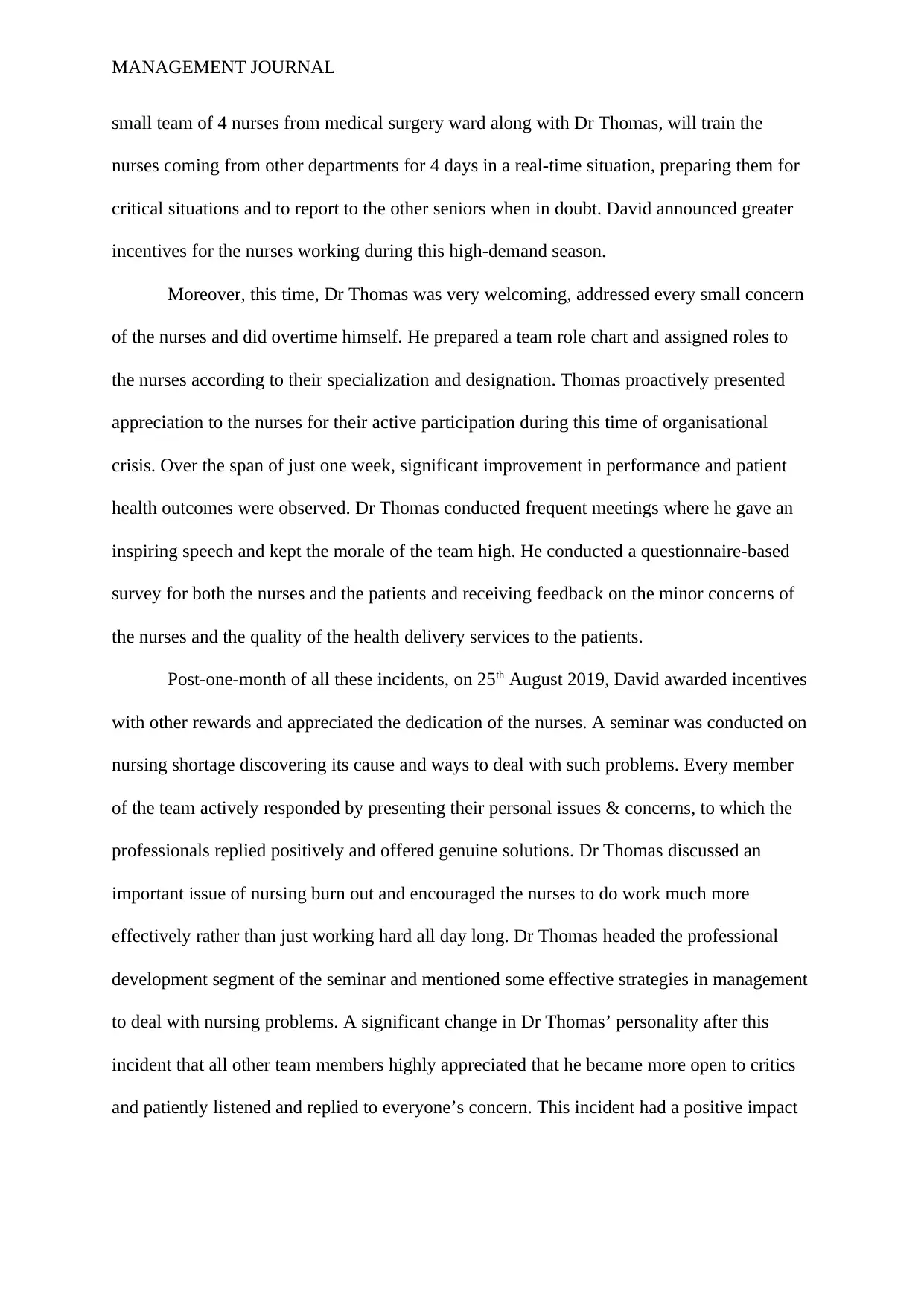
MANAGEMENT JOURNAL
small team of 4 nurses from medical surgery ward along with Dr Thomas, will train the
nurses coming from other departments for 4 days in a real-time situation, preparing them for
critical situations and to report to the other seniors when in doubt. David announced greater
incentives for the nurses working during this high-demand season.
Moreover, this time, Dr Thomas was very welcoming, addressed every small concern
of the nurses and did overtime himself. He prepared a team role chart and assigned roles to
the nurses according to their specialization and designation. Thomas proactively presented
appreciation to the nurses for their active participation during this time of organisational
crisis. Over the span of just one week, significant improvement in performance and patient
health outcomes were observed. Dr Thomas conducted frequent meetings where he gave an
inspiring speech and kept the morale of the team high. He conducted a questionnaire-based
survey for both the nurses and the patients and receiving feedback on the minor concerns of
the nurses and the quality of the health delivery services to the patients.
Post-one-month of all these incidents, on 25th August 2019, David awarded incentives
with other rewards and appreciated the dedication of the nurses. A seminar was conducted on
nursing shortage discovering its cause and ways to deal with such problems. Every member
of the team actively responded by presenting their personal issues & concerns, to which the
professionals replied positively and offered genuine solutions. Dr Thomas discussed an
important issue of nursing burn out and encouraged the nurses to do work much more
effectively rather than just working hard all day long. Dr Thomas headed the professional
development segment of the seminar and mentioned some effective strategies in management
to deal with nursing problems. A significant change in Dr Thomas’ personality after this
incident that all other team members highly appreciated that he became more open to critics
and patiently listened and replied to everyone’s concern. This incident had a positive impact
small team of 4 nurses from medical surgery ward along with Dr Thomas, will train the
nurses coming from other departments for 4 days in a real-time situation, preparing them for
critical situations and to report to the other seniors when in doubt. David announced greater
incentives for the nurses working during this high-demand season.
Moreover, this time, Dr Thomas was very welcoming, addressed every small concern
of the nurses and did overtime himself. He prepared a team role chart and assigned roles to
the nurses according to their specialization and designation. Thomas proactively presented
appreciation to the nurses for their active participation during this time of organisational
crisis. Over the span of just one week, significant improvement in performance and patient
health outcomes were observed. Dr Thomas conducted frequent meetings where he gave an
inspiring speech and kept the morale of the team high. He conducted a questionnaire-based
survey for both the nurses and the patients and receiving feedback on the minor concerns of
the nurses and the quality of the health delivery services to the patients.
Post-one-month of all these incidents, on 25th August 2019, David awarded incentives
with other rewards and appreciated the dedication of the nurses. A seminar was conducted on
nursing shortage discovering its cause and ways to deal with such problems. Every member
of the team actively responded by presenting their personal issues & concerns, to which the
professionals replied positively and offered genuine solutions. Dr Thomas discussed an
important issue of nursing burn out and encouraged the nurses to do work much more
effectively rather than just working hard all day long. Dr Thomas headed the professional
development segment of the seminar and mentioned some effective strategies in management
to deal with nursing problems. A significant change in Dr Thomas’ personality after this
incident that all other team members highly appreciated that he became more open to critics
and patiently listened and replied to everyone’s concern. This incident had a positive impact
Paraphrase This Document
Need a fresh take? Get an instant paraphrase of this document with our AI Paraphraser
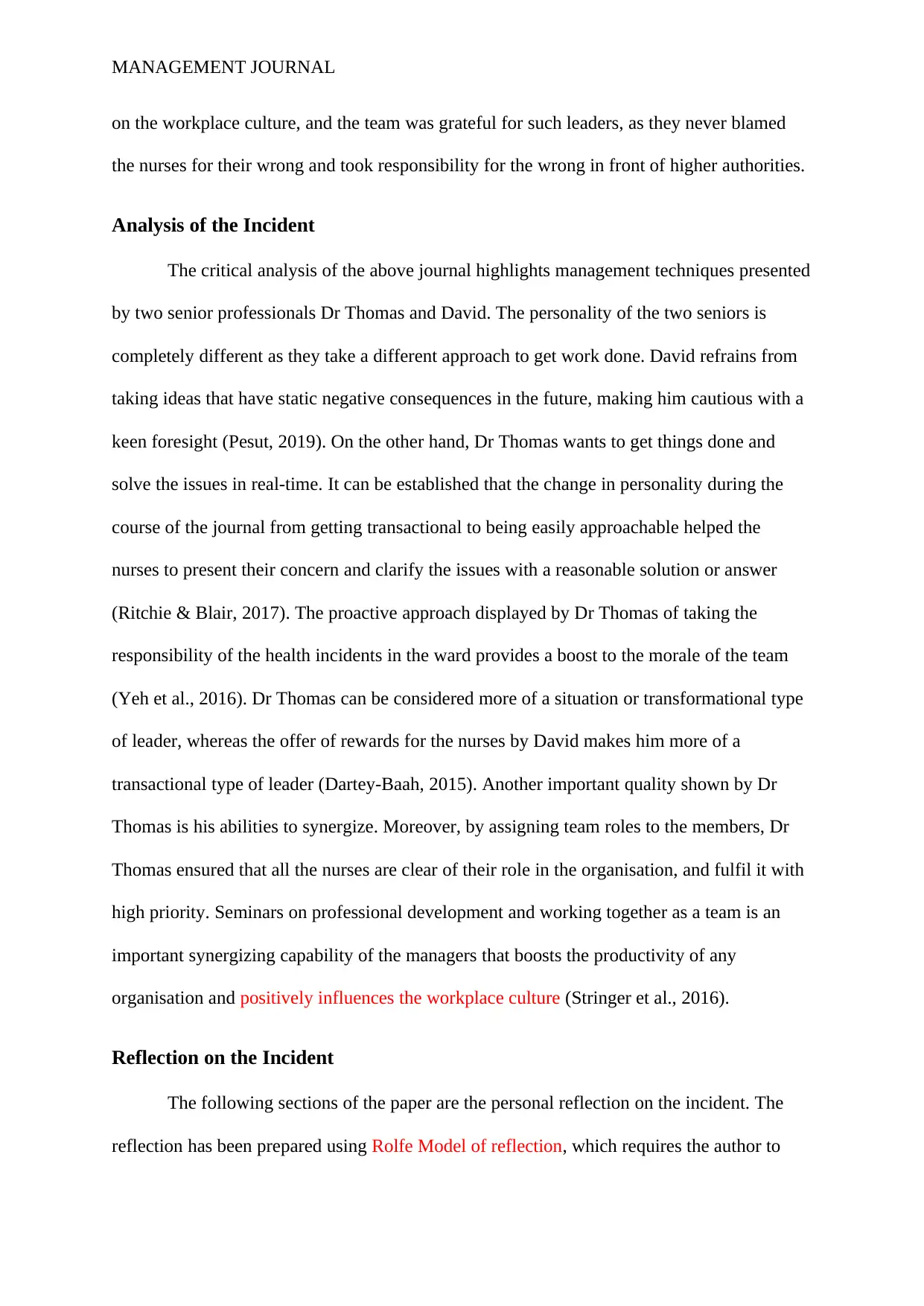
MANAGEMENT JOURNAL
on the workplace culture, and the team was grateful for such leaders, as they never blamed
the nurses for their wrong and took responsibility for the wrong in front of higher authorities.
Analysis of the Incident
The critical analysis of the above journal highlights management techniques presented
by two senior professionals Dr Thomas and David. The personality of the two seniors is
completely different as they take a different approach to get work done. David refrains from
taking ideas that have static negative consequences in the future, making him cautious with a
keen foresight (Pesut, 2019). On the other hand, Dr Thomas wants to get things done and
solve the issues in real-time. It can be established that the change in personality during the
course of the journal from getting transactional to being easily approachable helped the
nurses to present their concern and clarify the issues with a reasonable solution or answer
(Ritchie & Blair, 2017). The proactive approach displayed by Dr Thomas of taking the
responsibility of the health incidents in the ward provides a boost to the morale of the team
(Yeh et al., 2016). Dr Thomas can be considered more of a situation or transformational type
of leader, whereas the offer of rewards for the nurses by David makes him more of a
transactional type of leader (Dartey-Baah, 2015). Another important quality shown by Dr
Thomas is his abilities to synergize. Moreover, by assigning team roles to the members, Dr
Thomas ensured that all the nurses are clear of their role in the organisation, and fulfil it with
high priority. Seminars on professional development and working together as a team is an
important synergizing capability of the managers that boosts the productivity of any
organisation and positively influences the workplace culture (Stringer et al., 2016).
Reflection on the Incident
The following sections of the paper are the personal reflection on the incident. The
reflection has been prepared using Rolfe Model of reflection, which requires the author to
on the workplace culture, and the team was grateful for such leaders, as they never blamed
the nurses for their wrong and took responsibility for the wrong in front of higher authorities.
Analysis of the Incident
The critical analysis of the above journal highlights management techniques presented
by two senior professionals Dr Thomas and David. The personality of the two seniors is
completely different as they take a different approach to get work done. David refrains from
taking ideas that have static negative consequences in the future, making him cautious with a
keen foresight (Pesut, 2019). On the other hand, Dr Thomas wants to get things done and
solve the issues in real-time. It can be established that the change in personality during the
course of the journal from getting transactional to being easily approachable helped the
nurses to present their concern and clarify the issues with a reasonable solution or answer
(Ritchie & Blair, 2017). The proactive approach displayed by Dr Thomas of taking the
responsibility of the health incidents in the ward provides a boost to the morale of the team
(Yeh et al., 2016). Dr Thomas can be considered more of a situation or transformational type
of leader, whereas the offer of rewards for the nurses by David makes him more of a
transactional type of leader (Dartey-Baah, 2015). Another important quality shown by Dr
Thomas is his abilities to synergize. Moreover, by assigning team roles to the members, Dr
Thomas ensured that all the nurses are clear of their role in the organisation, and fulfil it with
high priority. Seminars on professional development and working together as a team is an
important synergizing capability of the managers that boosts the productivity of any
organisation and positively influences the workplace culture (Stringer et al., 2016).
Reflection on the Incident
The following sections of the paper are the personal reflection on the incident. The
reflection has been prepared using Rolfe Model of reflection, which requires the author to
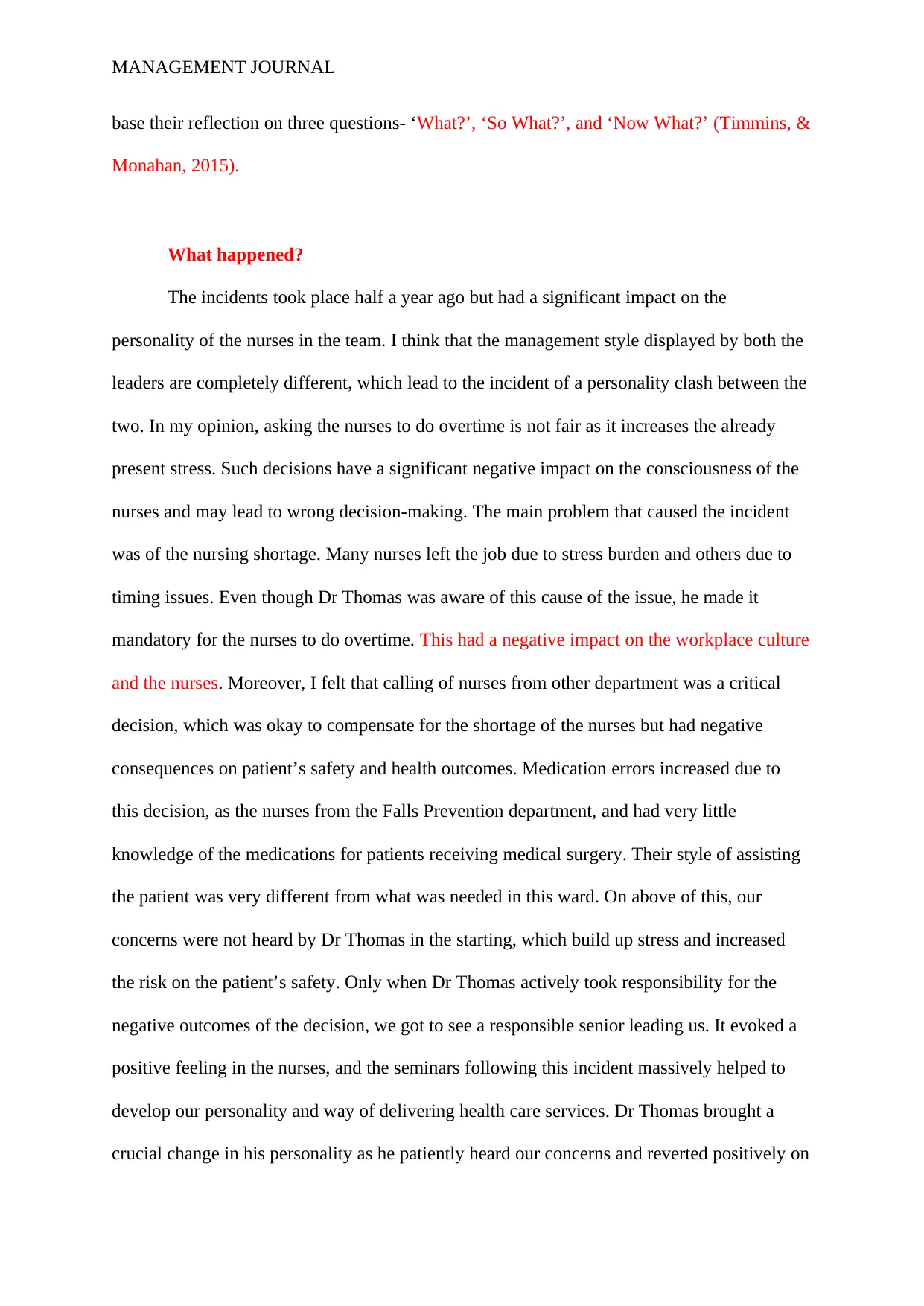
MANAGEMENT JOURNAL
base their reflection on three questions- ‘What?’, ‘So What?’, and ‘Now What?’ (Timmins, &
Monahan, 2015).
What happened?
The incidents took place half a year ago but had a significant impact on the
personality of the nurses in the team. I think that the management style displayed by both the
leaders are completely different, which lead to the incident of a personality clash between the
two. In my opinion, asking the nurses to do overtime is not fair as it increases the already
present stress. Such decisions have a significant negative impact on the consciousness of the
nurses and may lead to wrong decision-making. The main problem that caused the incident
was of the nursing shortage. Many nurses left the job due to stress burden and others due to
timing issues. Even though Dr Thomas was aware of this cause of the issue, he made it
mandatory for the nurses to do overtime. This had a negative impact on the workplace culture
and the nurses. Moreover, I felt that calling of nurses from other department was a critical
decision, which was okay to compensate for the shortage of the nurses but had negative
consequences on patient’s safety and health outcomes. Medication errors increased due to
this decision, as the nurses from the Falls Prevention department, and had very little
knowledge of the medications for patients receiving medical surgery. Their style of assisting
the patient was very different from what was needed in this ward. On above of this, our
concerns were not heard by Dr Thomas in the starting, which build up stress and increased
the risk on the patient’s safety. Only when Dr Thomas actively took responsibility for the
negative outcomes of the decision, we got to see a responsible senior leading us. It evoked a
positive feeling in the nurses, and the seminars following this incident massively helped to
develop our personality and way of delivering health care services. Dr Thomas brought a
crucial change in his personality as he patiently heard our concerns and reverted positively on
base their reflection on three questions- ‘What?’, ‘So What?’, and ‘Now What?’ (Timmins, &
Monahan, 2015).
What happened?
The incidents took place half a year ago but had a significant impact on the
personality of the nurses in the team. I think that the management style displayed by both the
leaders are completely different, which lead to the incident of a personality clash between the
two. In my opinion, asking the nurses to do overtime is not fair as it increases the already
present stress. Such decisions have a significant negative impact on the consciousness of the
nurses and may lead to wrong decision-making. The main problem that caused the incident
was of the nursing shortage. Many nurses left the job due to stress burden and others due to
timing issues. Even though Dr Thomas was aware of this cause of the issue, he made it
mandatory for the nurses to do overtime. This had a negative impact on the workplace culture
and the nurses. Moreover, I felt that calling of nurses from other department was a critical
decision, which was okay to compensate for the shortage of the nurses but had negative
consequences on patient’s safety and health outcomes. Medication errors increased due to
this decision, as the nurses from the Falls Prevention department, and had very little
knowledge of the medications for patients receiving medical surgery. Their style of assisting
the patient was very different from what was needed in this ward. On above of this, our
concerns were not heard by Dr Thomas in the starting, which build up stress and increased
the risk on the patient’s safety. Only when Dr Thomas actively took responsibility for the
negative outcomes of the decision, we got to see a responsible senior leading us. It evoked a
positive feeling in the nurses, and the seminars following this incident massively helped to
develop our personality and way of delivering health care services. Dr Thomas brought a
crucial change in his personality as he patiently heard our concerns and reverted positively on
⊘ This is a preview!⊘
Do you want full access?
Subscribe today to unlock all pages.

Trusted by 1+ million students worldwide
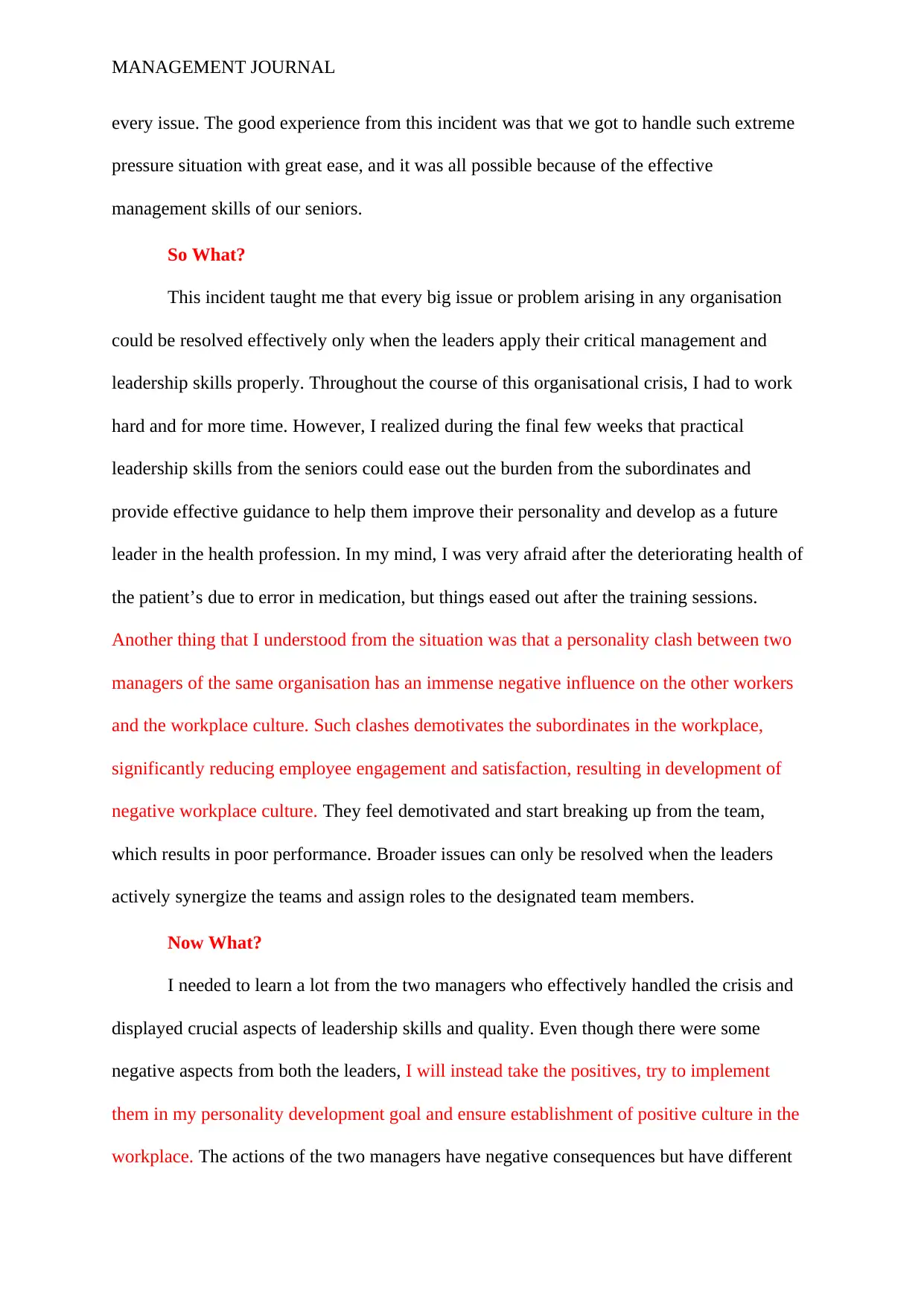
MANAGEMENT JOURNAL
every issue. The good experience from this incident was that we got to handle such extreme
pressure situation with great ease, and it was all possible because of the effective
management skills of our seniors.
So What?
This incident taught me that every big issue or problem arising in any organisation
could be resolved effectively only when the leaders apply their critical management and
leadership skills properly. Throughout the course of this organisational crisis, I had to work
hard and for more time. However, I realized during the final few weeks that practical
leadership skills from the seniors could ease out the burden from the subordinates and
provide effective guidance to help them improve their personality and develop as a future
leader in the health profession. In my mind, I was very afraid after the deteriorating health of
the patient’s due to error in medication, but things eased out after the training sessions.
Another thing that I understood from the situation was that a personality clash between two
managers of the same organisation has an immense negative influence on the other workers
and the workplace culture. Such clashes demotivates the subordinates in the workplace,
significantly reducing employee engagement and satisfaction, resulting in development of
negative workplace culture. They feel demotivated and start breaking up from the team,
which results in poor performance. Broader issues can only be resolved when the leaders
actively synergize the teams and assign roles to the designated team members.
Now What?
I needed to learn a lot from the two managers who effectively handled the crisis and
displayed crucial aspects of leadership skills and quality. Even though there were some
negative aspects from both the leaders, I will instead take the positives, try to implement
them in my personality development goal and ensure establishment of positive culture in the
workplace. The actions of the two managers have negative consequences but have different
every issue. The good experience from this incident was that we got to handle such extreme
pressure situation with great ease, and it was all possible because of the effective
management skills of our seniors.
So What?
This incident taught me that every big issue or problem arising in any organisation
could be resolved effectively only when the leaders apply their critical management and
leadership skills properly. Throughout the course of this organisational crisis, I had to work
hard and for more time. However, I realized during the final few weeks that practical
leadership skills from the seniors could ease out the burden from the subordinates and
provide effective guidance to help them improve their personality and develop as a future
leader in the health profession. In my mind, I was very afraid after the deteriorating health of
the patient’s due to error in medication, but things eased out after the training sessions.
Another thing that I understood from the situation was that a personality clash between two
managers of the same organisation has an immense negative influence on the other workers
and the workplace culture. Such clashes demotivates the subordinates in the workplace,
significantly reducing employee engagement and satisfaction, resulting in development of
negative workplace culture. They feel demotivated and start breaking up from the team,
which results in poor performance. Broader issues can only be resolved when the leaders
actively synergize the teams and assign roles to the designated team members.
Now What?
I needed to learn a lot from the two managers who effectively handled the crisis and
displayed crucial aspects of leadership skills and quality. Even though there were some
negative aspects from both the leaders, I will instead take the positives, try to implement
them in my personality development goal and ensure establishment of positive culture in the
workplace. The actions of the two managers have negative consequences but have different
Paraphrase This Document
Need a fresh take? Get an instant paraphrase of this document with our AI Paraphraser
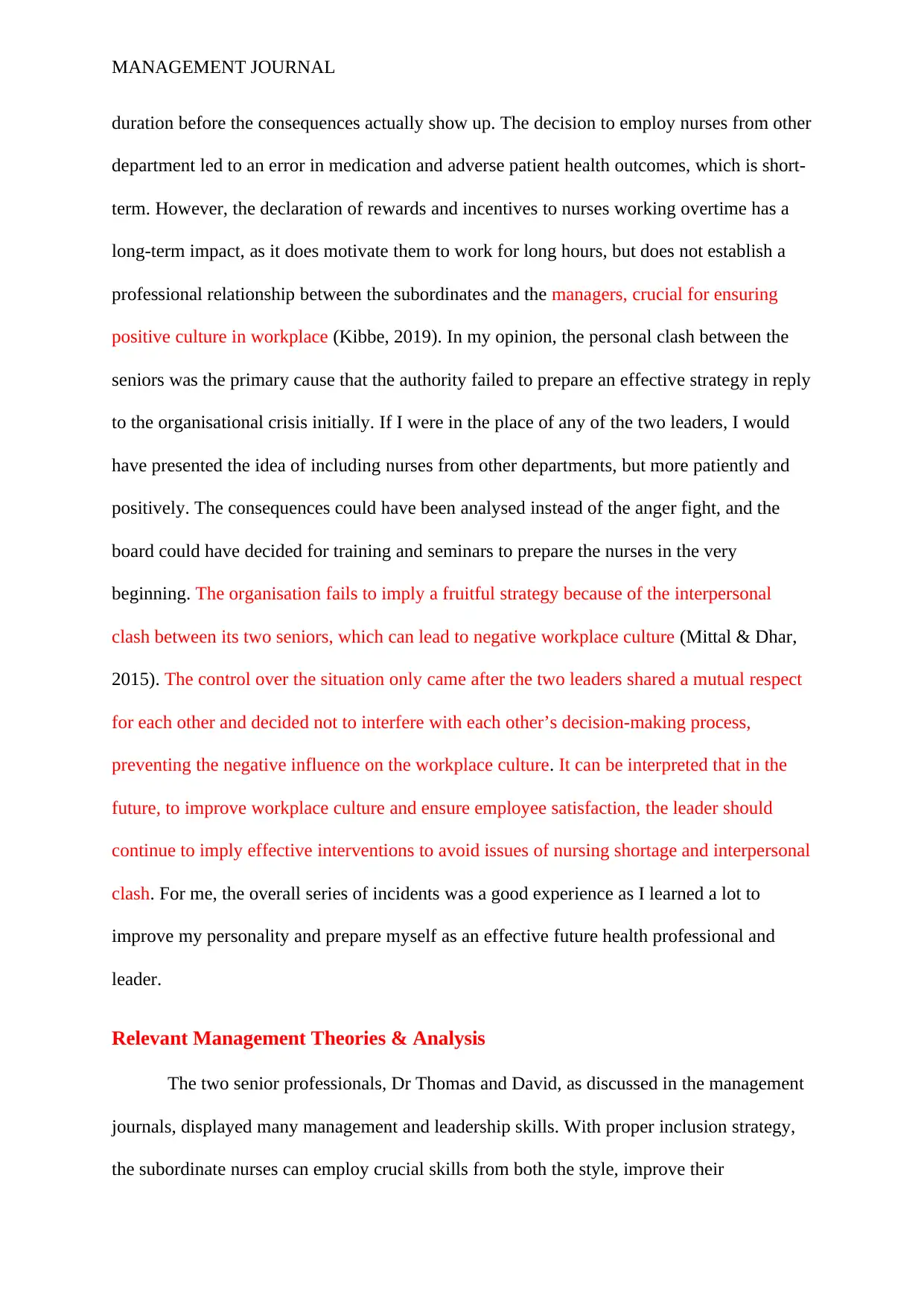
MANAGEMENT JOURNAL
duration before the consequences actually show up. The decision to employ nurses from other
department led to an error in medication and adverse patient health outcomes, which is short-
term. However, the declaration of rewards and incentives to nurses working overtime has a
long-term impact, as it does motivate them to work for long hours, but does not establish a
professional relationship between the subordinates and the managers, crucial for ensuring
positive culture in workplace (Kibbe, 2019). In my opinion, the personal clash between the
seniors was the primary cause that the authority failed to prepare an effective strategy in reply
to the organisational crisis initially. If I were in the place of any of the two leaders, I would
have presented the idea of including nurses from other departments, but more patiently and
positively. The consequences could have been analysed instead of the anger fight, and the
board could have decided for training and seminars to prepare the nurses in the very
beginning. The organisation fails to imply a fruitful strategy because of the interpersonal
clash between its two seniors, which can lead to negative workplace culture (Mittal & Dhar,
2015). The control over the situation only came after the two leaders shared a mutual respect
for each other and decided not to interfere with each other’s decision-making process,
preventing the negative influence on the workplace culture. It can be interpreted that in the
future, to improve workplace culture and ensure employee satisfaction, the leader should
continue to imply effective interventions to avoid issues of nursing shortage and interpersonal
clash. For me, the overall series of incidents was a good experience as I learned a lot to
improve my personality and prepare myself as an effective future health professional and
leader.
Relevant Management Theories & Analysis
The two senior professionals, Dr Thomas and David, as discussed in the management
journals, displayed many management and leadership skills. With proper inclusion strategy,
the subordinate nurses can employ crucial skills from both the style, improve their
duration before the consequences actually show up. The decision to employ nurses from other
department led to an error in medication and adverse patient health outcomes, which is short-
term. However, the declaration of rewards and incentives to nurses working overtime has a
long-term impact, as it does motivate them to work for long hours, but does not establish a
professional relationship between the subordinates and the managers, crucial for ensuring
positive culture in workplace (Kibbe, 2019). In my opinion, the personal clash between the
seniors was the primary cause that the authority failed to prepare an effective strategy in reply
to the organisational crisis initially. If I were in the place of any of the two leaders, I would
have presented the idea of including nurses from other departments, but more patiently and
positively. The consequences could have been analysed instead of the anger fight, and the
board could have decided for training and seminars to prepare the nurses in the very
beginning. The organisation fails to imply a fruitful strategy because of the interpersonal
clash between its two seniors, which can lead to negative workplace culture (Mittal & Dhar,
2015). The control over the situation only came after the two leaders shared a mutual respect
for each other and decided not to interfere with each other’s decision-making process,
preventing the negative influence on the workplace culture. It can be interpreted that in the
future, to improve workplace culture and ensure employee satisfaction, the leader should
continue to imply effective interventions to avoid issues of nursing shortage and interpersonal
clash. For me, the overall series of incidents was a good experience as I learned a lot to
improve my personality and prepare myself as an effective future health professional and
leader.
Relevant Management Theories & Analysis
The two senior professionals, Dr Thomas and David, as discussed in the management
journals, displayed many management and leadership skills. With proper inclusion strategy,
the subordinate nurses can employ crucial skills from both the style, improve their
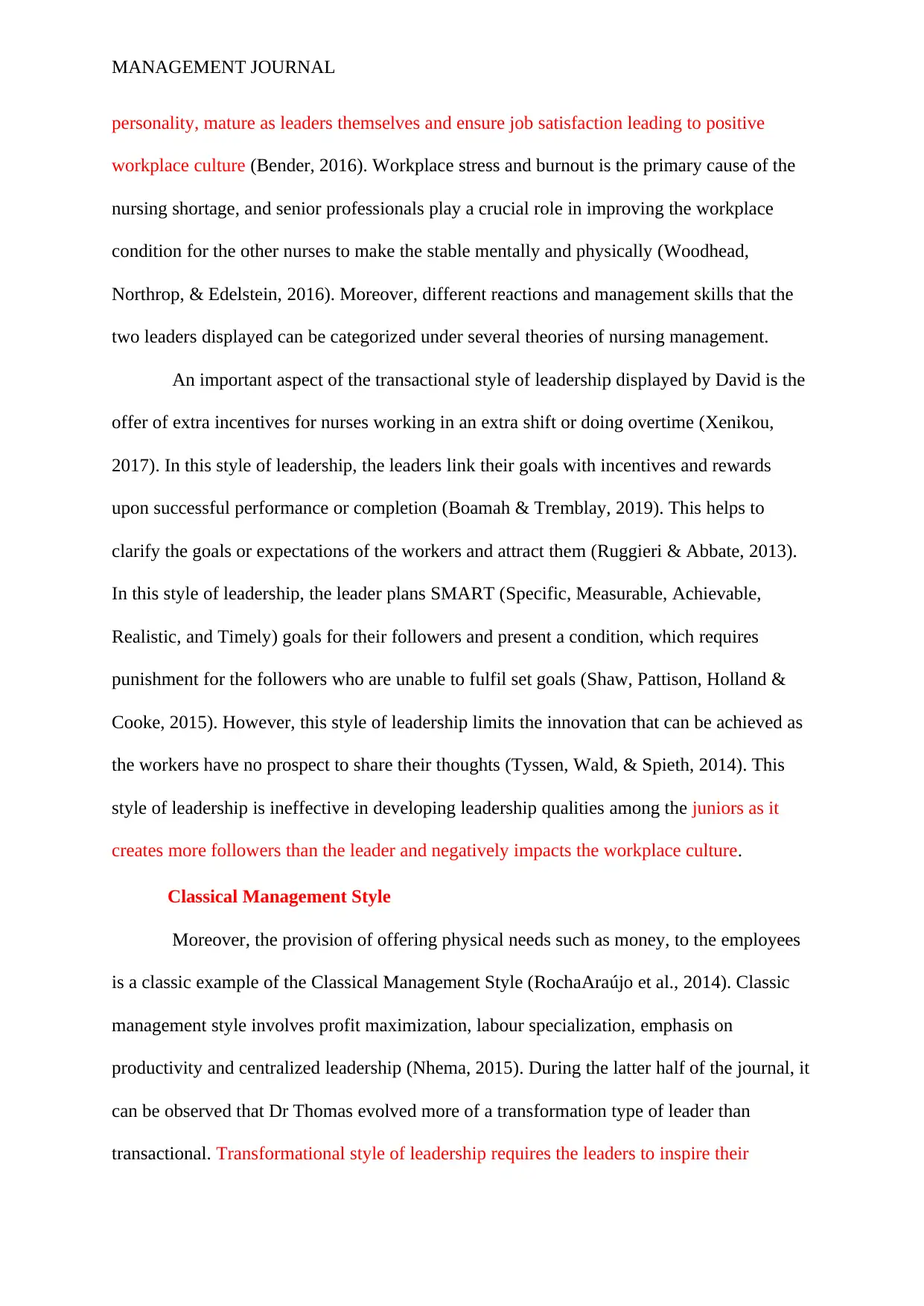
MANAGEMENT JOURNAL
personality, mature as leaders themselves and ensure job satisfaction leading to positive
workplace culture (Bender, 2016). Workplace stress and burnout is the primary cause of the
nursing shortage, and senior professionals play a crucial role in improving the workplace
condition for the other nurses to make the stable mentally and physically (Woodhead,
Northrop, & Edelstein, 2016). Moreover, different reactions and management skills that the
two leaders displayed can be categorized under several theories of nursing management.
An important aspect of the transactional style of leadership displayed by David is the
offer of extra incentives for nurses working in an extra shift or doing overtime (Xenikou,
2017). In this style of leadership, the leaders link their goals with incentives and rewards
upon successful performance or completion (Boamah & Tremblay, 2019). This helps to
clarify the goals or expectations of the workers and attract them (Ruggieri & Abbate, 2013).
In this style of leadership, the leader plans SMART (Specific, Measurable, Achievable,
Realistic, and Timely) goals for their followers and present a condition, which requires
punishment for the followers who are unable to fulfil set goals (Shaw, Pattison, Holland &
Cooke, 2015). However, this style of leadership limits the innovation that can be achieved as
the workers have no prospect to share their thoughts (Tyssen, Wald, & Spieth, 2014). This
style of leadership is ineffective in developing leadership qualities among the juniors as it
creates more followers than the leader and negatively impacts the workplace culture.
Classical Management Style
Moreover, the provision of offering physical needs such as money, to the employees
is a classic example of the Classical Management Style (RochaAraújo et al., 2014). Classic
management style involves profit maximization, labour specialization, emphasis on
productivity and centralized leadership (Nhema, 2015). During the latter half of the journal, it
can be observed that Dr Thomas evolved more of a transformation type of leader than
transactional. Transformational style of leadership requires the leaders to inspire their
personality, mature as leaders themselves and ensure job satisfaction leading to positive
workplace culture (Bender, 2016). Workplace stress and burnout is the primary cause of the
nursing shortage, and senior professionals play a crucial role in improving the workplace
condition for the other nurses to make the stable mentally and physically (Woodhead,
Northrop, & Edelstein, 2016). Moreover, different reactions and management skills that the
two leaders displayed can be categorized under several theories of nursing management.
An important aspect of the transactional style of leadership displayed by David is the
offer of extra incentives for nurses working in an extra shift or doing overtime (Xenikou,
2017). In this style of leadership, the leaders link their goals with incentives and rewards
upon successful performance or completion (Boamah & Tremblay, 2019). This helps to
clarify the goals or expectations of the workers and attract them (Ruggieri & Abbate, 2013).
In this style of leadership, the leader plans SMART (Specific, Measurable, Achievable,
Realistic, and Timely) goals for their followers and present a condition, which requires
punishment for the followers who are unable to fulfil set goals (Shaw, Pattison, Holland &
Cooke, 2015). However, this style of leadership limits the innovation that can be achieved as
the workers have no prospect to share their thoughts (Tyssen, Wald, & Spieth, 2014). This
style of leadership is ineffective in developing leadership qualities among the juniors as it
creates more followers than the leader and negatively impacts the workplace culture.
Classical Management Style
Moreover, the provision of offering physical needs such as money, to the employees
is a classic example of the Classical Management Style (RochaAraújo et al., 2014). Classic
management style involves profit maximization, labour specialization, emphasis on
productivity and centralized leadership (Nhema, 2015). During the latter half of the journal, it
can be observed that Dr Thomas evolved more of a transformation type of leader than
transactional. Transformational style of leadership requires the leaders to inspire their
⊘ This is a preview!⊘
Do you want full access?
Subscribe today to unlock all pages.

Trusted by 1+ million students worldwide
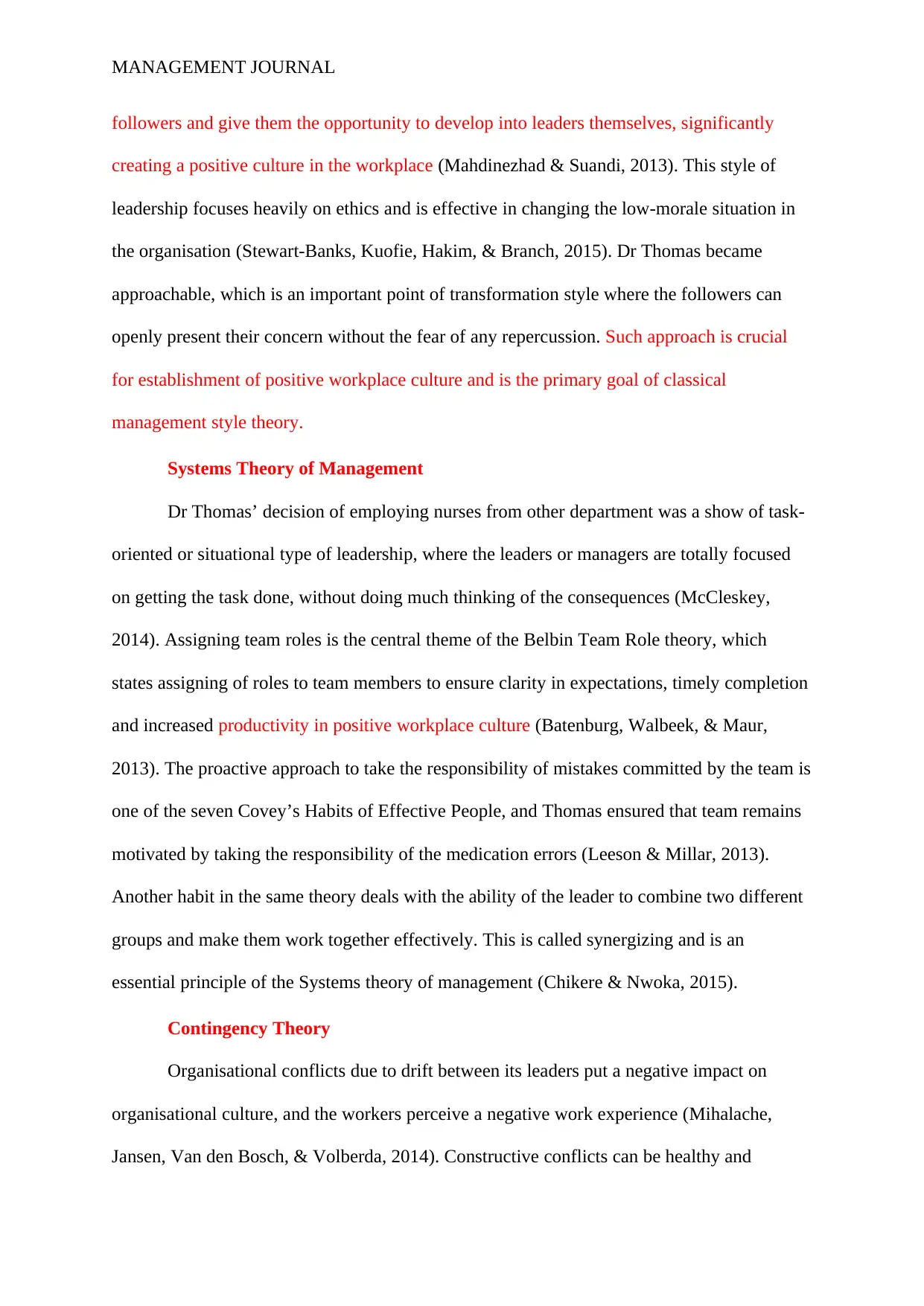
MANAGEMENT JOURNAL
followers and give them the opportunity to develop into leaders themselves, significantly
creating a positive culture in the workplace (Mahdinezhad & Suandi, 2013). This style of
leadership focuses heavily on ethics and is effective in changing the low-morale situation in
the organisation (Stewart-Banks, Kuofie, Hakim, & Branch, 2015). Dr Thomas became
approachable, which is an important point of transformation style where the followers can
openly present their concern without the fear of any repercussion. Such approach is crucial
for establishment of positive workplace culture and is the primary goal of classical
management style theory.
Systems Theory of Management
Dr Thomas’ decision of employing nurses from other department was a show of task-
oriented or situational type of leadership, where the leaders or managers are totally focused
on getting the task done, without doing much thinking of the consequences (McCleskey,
2014). Assigning team roles is the central theme of the Belbin Team Role theory, which
states assigning of roles to team members to ensure clarity in expectations, timely completion
and increased productivity in positive workplace culture (Batenburg, Walbeek, & Maur,
2013). The proactive approach to take the responsibility of mistakes committed by the team is
one of the seven Covey’s Habits of Effective People, and Thomas ensured that team remains
motivated by taking the responsibility of the medication errors (Leeson & Millar, 2013).
Another habit in the same theory deals with the ability of the leader to combine two different
groups and make them work together effectively. This is called synergizing and is an
essential principle of the Systems theory of management (Chikere & Nwoka, 2015).
Contingency Theory
Organisational conflicts due to drift between its leaders put a negative impact on
organisational culture, and the workers perceive a negative work experience (Mihalache,
Jansen, Van den Bosch, & Volberda, 2014). Constructive conflicts can be healthy and
followers and give them the opportunity to develop into leaders themselves, significantly
creating a positive culture in the workplace (Mahdinezhad & Suandi, 2013). This style of
leadership focuses heavily on ethics and is effective in changing the low-morale situation in
the organisation (Stewart-Banks, Kuofie, Hakim, & Branch, 2015). Dr Thomas became
approachable, which is an important point of transformation style where the followers can
openly present their concern without the fear of any repercussion. Such approach is crucial
for establishment of positive workplace culture and is the primary goal of classical
management style theory.
Systems Theory of Management
Dr Thomas’ decision of employing nurses from other department was a show of task-
oriented or situational type of leadership, where the leaders or managers are totally focused
on getting the task done, without doing much thinking of the consequences (McCleskey,
2014). Assigning team roles is the central theme of the Belbin Team Role theory, which
states assigning of roles to team members to ensure clarity in expectations, timely completion
and increased productivity in positive workplace culture (Batenburg, Walbeek, & Maur,
2013). The proactive approach to take the responsibility of mistakes committed by the team is
one of the seven Covey’s Habits of Effective People, and Thomas ensured that team remains
motivated by taking the responsibility of the medication errors (Leeson & Millar, 2013).
Another habit in the same theory deals with the ability of the leader to combine two different
groups and make them work together effectively. This is called synergizing and is an
essential principle of the Systems theory of management (Chikere & Nwoka, 2015).
Contingency Theory
Organisational conflicts due to drift between its leaders put a negative impact on
organisational culture, and the workers perceive a negative work experience (Mihalache,
Jansen, Van den Bosch, & Volberda, 2014). Constructive conflicts can be healthy and
Paraphrase This Document
Need a fresh take? Get an instant paraphrase of this document with our AI Paraphraser
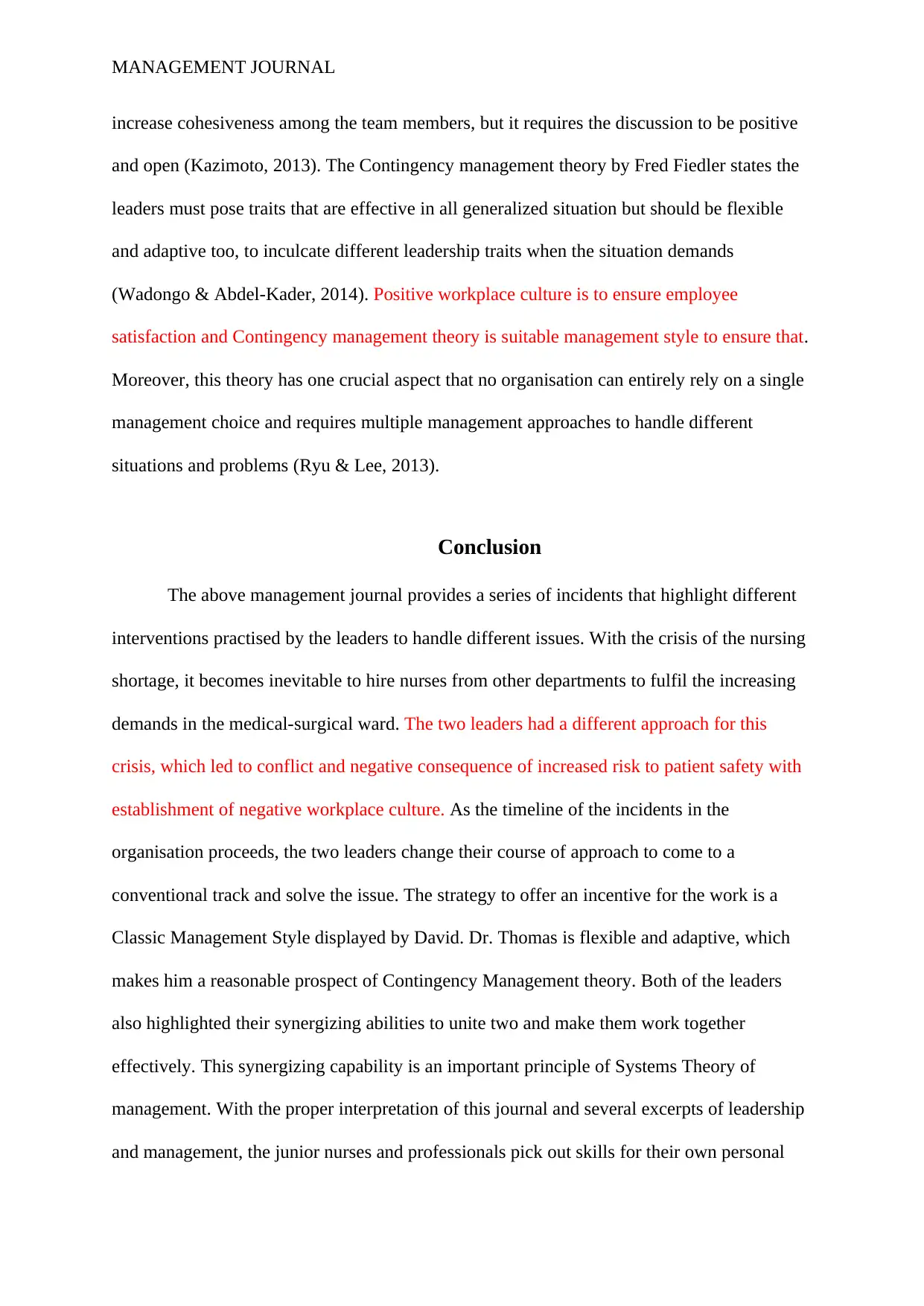
MANAGEMENT JOURNAL
increase cohesiveness among the team members, but it requires the discussion to be positive
and open (Kazimoto, 2013). The Contingency management theory by Fred Fiedler states the
leaders must pose traits that are effective in all generalized situation but should be flexible
and adaptive too, to inculcate different leadership traits when the situation demands
(Wadongo & Abdel-Kader, 2014). Positive workplace culture is to ensure employee
satisfaction and Contingency management theory is suitable management style to ensure that.
Moreover, this theory has one crucial aspect that no organisation can entirely rely on a single
management choice and requires multiple management approaches to handle different
situations and problems (Ryu & Lee, 2013).
Conclusion
The above management journal provides a series of incidents that highlight different
interventions practised by the leaders to handle different issues. With the crisis of the nursing
shortage, it becomes inevitable to hire nurses from other departments to fulfil the increasing
demands in the medical-surgical ward. The two leaders had a different approach for this
crisis, which led to conflict and negative consequence of increased risk to patient safety with
establishment of negative workplace culture. As the timeline of the incidents in the
organisation proceeds, the two leaders change their course of approach to come to a
conventional track and solve the issue. The strategy to offer an incentive for the work is a
Classic Management Style displayed by David. Dr. Thomas is flexible and adaptive, which
makes him a reasonable prospect of Contingency Management theory. Both of the leaders
also highlighted their synergizing abilities to unite two and make them work together
effectively. This synergizing capability is an important principle of Systems Theory of
management. With the proper interpretation of this journal and several excerpts of leadership
and management, the junior nurses and professionals pick out skills for their own personal
increase cohesiveness among the team members, but it requires the discussion to be positive
and open (Kazimoto, 2013). The Contingency management theory by Fred Fiedler states the
leaders must pose traits that are effective in all generalized situation but should be flexible
and adaptive too, to inculcate different leadership traits when the situation demands
(Wadongo & Abdel-Kader, 2014). Positive workplace culture is to ensure employee
satisfaction and Contingency management theory is suitable management style to ensure that.
Moreover, this theory has one crucial aspect that no organisation can entirely rely on a single
management choice and requires multiple management approaches to handle different
situations and problems (Ryu & Lee, 2013).
Conclusion
The above management journal provides a series of incidents that highlight different
interventions practised by the leaders to handle different issues. With the crisis of the nursing
shortage, it becomes inevitable to hire nurses from other departments to fulfil the increasing
demands in the medical-surgical ward. The two leaders had a different approach for this
crisis, which led to conflict and negative consequence of increased risk to patient safety with
establishment of negative workplace culture. As the timeline of the incidents in the
organisation proceeds, the two leaders change their course of approach to come to a
conventional track and solve the issue. The strategy to offer an incentive for the work is a
Classic Management Style displayed by David. Dr. Thomas is flexible and adaptive, which
makes him a reasonable prospect of Contingency Management theory. Both of the leaders
also highlighted their synergizing abilities to unite two and make them work together
effectively. This synergizing capability is an important principle of Systems Theory of
management. With the proper interpretation of this journal and several excerpts of leadership
and management, the junior nurses and professionals pick out skills for their own personal
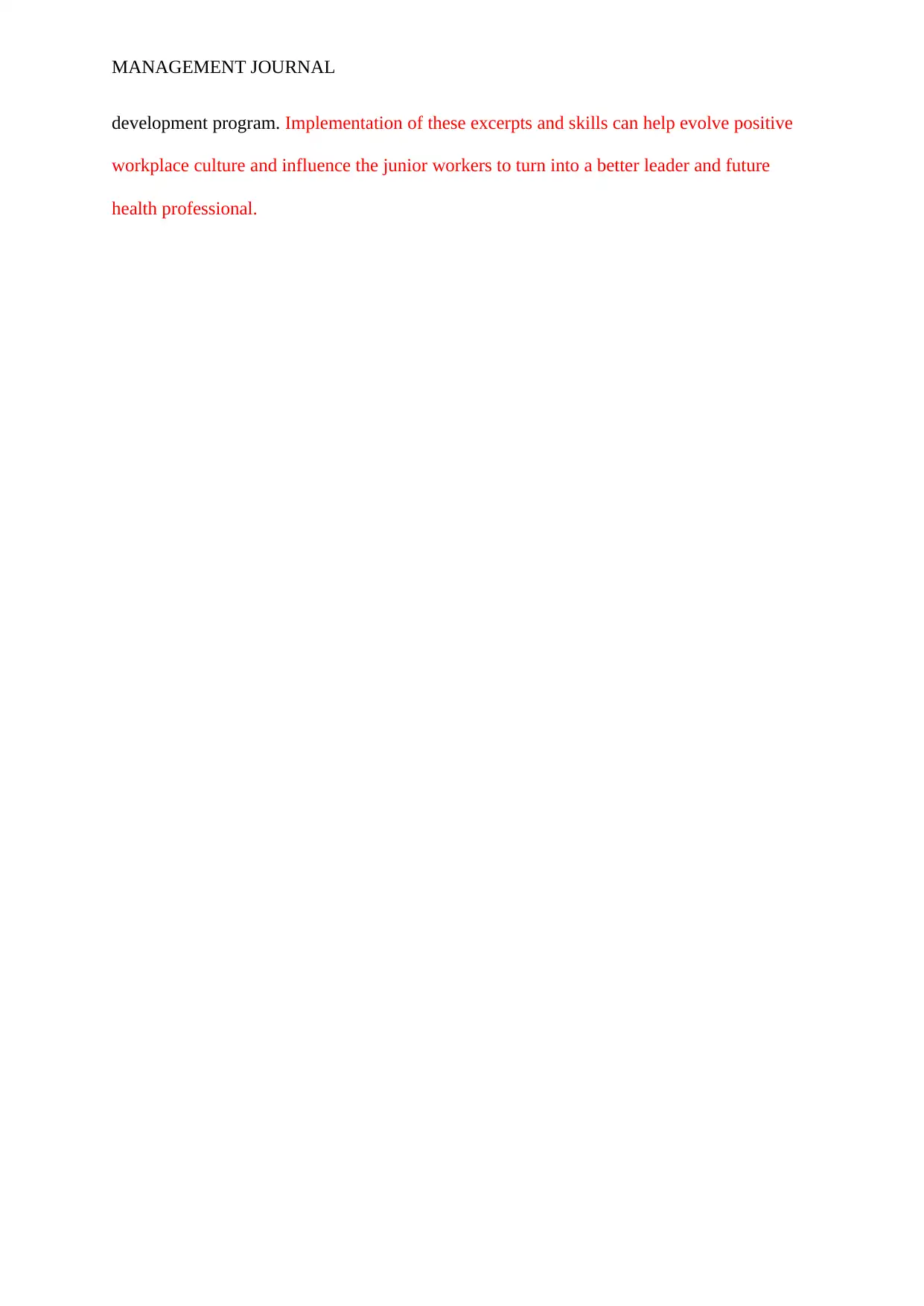
MANAGEMENT JOURNAL
development program. Implementation of these excerpts and skills can help evolve positive
workplace culture and influence the junior workers to turn into a better leader and future
health professional.
development program. Implementation of these excerpts and skills can help evolve positive
workplace culture and influence the junior workers to turn into a better leader and future
health professional.
⊘ This is a preview!⊘
Do you want full access?
Subscribe today to unlock all pages.

Trusted by 1+ million students worldwide
1 out of 17
Your All-in-One AI-Powered Toolkit for Academic Success.
+13062052269
info@desklib.com
Available 24*7 on WhatsApp / Email
![[object Object]](/_next/static/media/star-bottom.7253800d.svg)
Unlock your academic potential
Copyright © 2020–2025 A2Z Services. All Rights Reserved. Developed and managed by ZUCOL.
